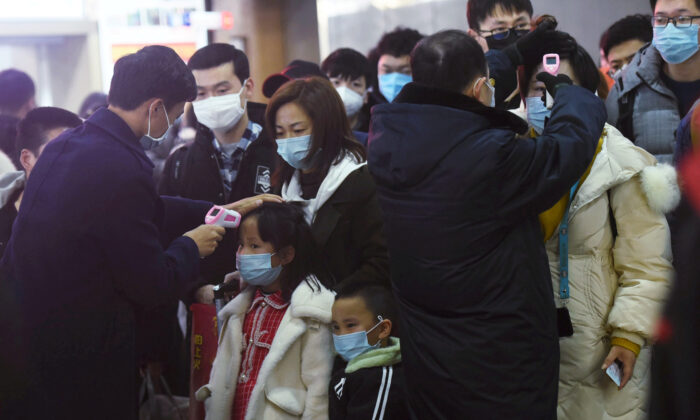China Widens Lockdowns, Closes Tourist Sites as Virus Death Toll Rises to 26
Doctor Wei said the panic did not sink in until Jan. 21, two days before his hometown became under lockdown.
Every morning, around a dozen patients would flock to the community clinic he worked at, all presenting symptoms of fever or the flu.
He said it has been like this for the past month and a half.
The viral pneumonia, caused by a virus known as 2019-nCov, infected its first patient in the central Chinese city of Wuhan on Dec. 12.
It has since spread to more than 800 people across the country.
Many Wuhan residents were nonplussed by the illness until authorities on Jan. 22 issued a notice to quarantine the city and shut down all public transportation. Such lockdown measures soon expanded to seven other cities in the city of Hubei, where Wuhan is the capital.
 Security personnel check the temperature of passengers in the Wharf at the Yangtze River in Wuhan city, Hubei province, China, on January 22, 2020. (Photo by Getty Images)
Security personnel check the temperature of passengers in the Wharf at the Yangtze River in Wuhan city, Hubei province, China, on January 22, 2020. (Photo by Getty Images)No Clear Guidelines
Long before the city took action, Wei said he heard rumors among his peers about a virus in November, but he did not dare to speak out for fear of reprisal.
When the outbreak occurred in December, Wuhan authorities did not give clear guidelines and proper equipment for small clinics like his, according to Wei. He said that they were short on facial masks, and lacked hazmat suits.
At Wei’s workplace, they didn’t quarantine patients who exhibited pneumonia-like symptoms.
Working in such conditions, he suspects some staff may have contracted the virus from patients. Currently, five out of roughly 50 healthcare workers have symptoms of the disease, but have not yet been tested.
His clinic also did not have the authority to do much beyond the initial screening. If patients appear feverish, he would take their body temperature and perform a blood test. Those with symptoms of the viral pneumonia would be referred to one of the 61 approved medical centers for treatment in Wuhan. They would then have to wait in line along with hundreds of others.
“We knew the patients’ clinical traits but because the authorities concealed the data, we don’t know how far it [the virus] has spread. It will only get bigger,” he said.
Wei himself also has the symptoms: lung infections, a sore throat, and chest pains. But he has no plans to go to the hospital, where he said people could wait from morning until evening. Instead, he intends to stay at home in isolation.
Widespread Worries
Masks have become a common sight on Wuhan streets. Citizens are now flooding the supermarkets to stockpile food, leading to a steep surge in prices.
According to pictures from Weibo, there was cauliflower priced at around 40 yuan ($5.8) a head and cabbage at 35 yuan ($5.05)—around five times the normal price.
Videos from Weibo also showed people elbowing each other to reach the vegetables.
 A Wuhan resident, masked, buys vegetables at a market in Hubei Province, China amid the coronavirus outbreak, on Jan. 23, 2020. (Getty Images)
A Wuhan resident, masked, buys vegetables at a market in Hubei Province, China amid the coronavirus outbreak, on Jan. 23, 2020. (Getty Images)Xiao, a resident of the city’s Wuchang district, said he stayed away from areas around hospitals and public places for fear of catching the virus.
He said his company on Jan. 21 started requiring every staff member to wear masks and take their own body temperature. “That’s when we knew it got serious,” Xiao said.
Another Wuhan citizen surnamed Liu said that he knew of many workplaces that had issued notices asking staff not to travel back to their hometown for the Lunar New Year, China’s peak travel season only days away.
Hu, who lives in the Jiangan district, said that masks in pharmacies were selling out. He criticized authorities for their conflicting statements leading up to the worsening of the outbreak.
“It’s classic bureaucratic style. They don’t see the everyday people’s lives as lives,” he said. “No one cared before things got out of hand.”
A nurse from Wuhan Xiehe Hospital said some staff in her department have become sick and have been isolated. While her husband has stayed with her in the city, they have send their their children and parents out of town.
“We are risking our life at work,” she wrote in an emailed letter obtained by The Epoch Times
“It’s very possible that with one notice, I would not be allowed home and isolated at the hospital,” she said. “It’s very heart-chilling. No one treats us as a person in this society.”
This article is from the Internet:Panic Stirs in Chinese City Where Deadly Virus Broke Out
Chinese Viral Outbreak Could Be ’10 Times the Scale of SARS,’ Expert Says
